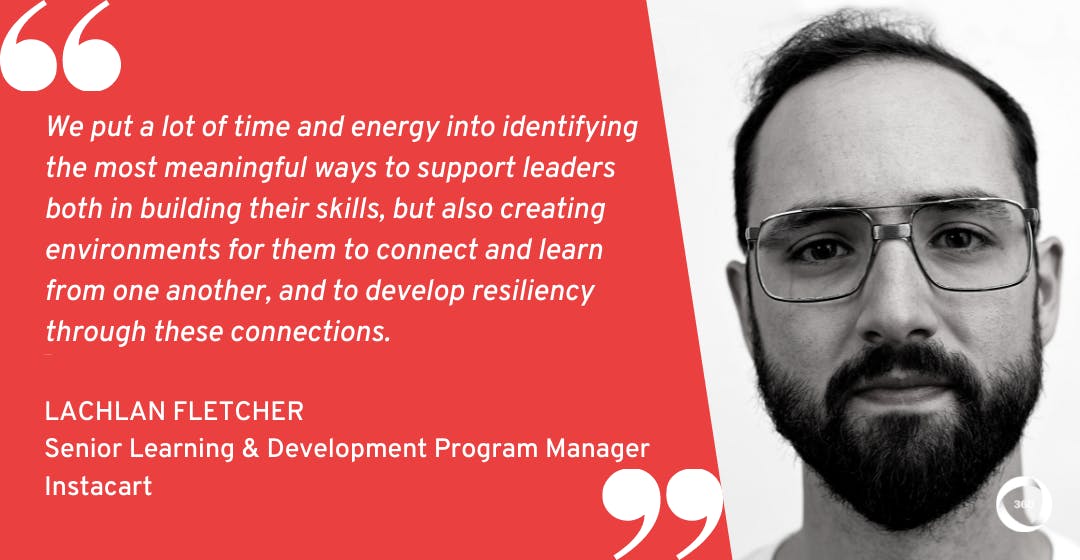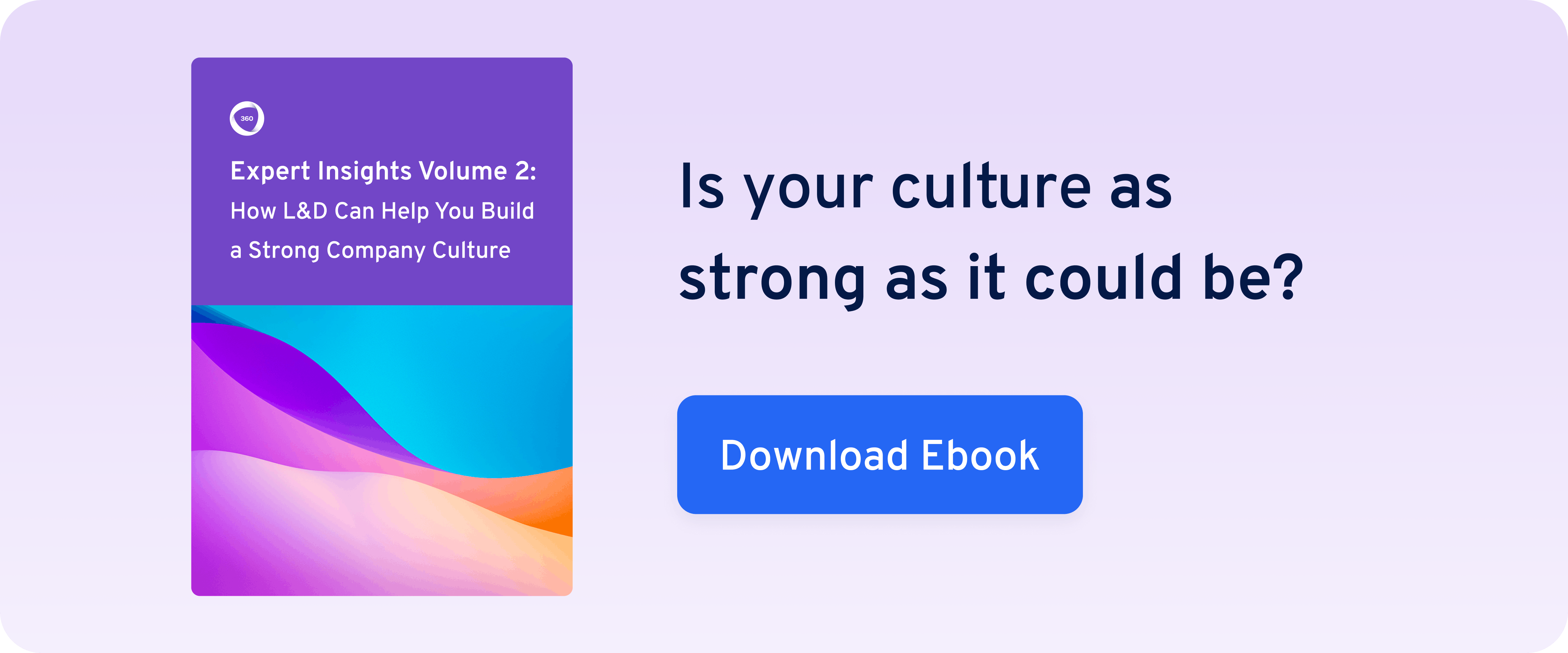
How Instacart Supports and Challenges Managers with Tailored Peer Discussion Circles
Leaders have a critical role to play in times of crisis. In organizations of every size, it’s managers and directors who steer the course and help teams to cope and thrive. But to set the right tone, leaders need the right resources, and the right level of support.
In my first ever interview as co-host of CLO Connect, it was my pleasure to sit down with Lachlan Fletcher, Senior Learning & Development Program Manager at grocery delivery outfit Instacart. Lachlan was kind enough to explain how Instacart supports its managers with peer discussion circles, and how sharing stories helps to navigate troubling times.
And if you’re wondering where you might have seen me before, be sure to check out Learning Audrey, our five-part SaaS docu-series charting my first months on the job as 360Learning’s new Senior Learning Manager.
Loving what you’re reading? Come and join the L&D Collective for more great learning insights, resources, and events!
The value of leadership in troubling times
Lachlan started our conversation by telling me all about Instacart’s approach to supporting leadership throughout the COVID-19 pandemic.
“Right now, one of the People Development Team’s biggest investment areas is leadership development for managers, individual contributors, and people who think about strategy and teams generally, regardless of what roles they have.”
“Over the course of the pandemic, Instacart has grown significantly, which creates new challenges for our leadership,” says Lachlan. “I joined Instacart in the Spring of 2020 as the pandemic was taking hold, so I was able to see this growth first-hand.”
As Lachlan explains, Instacart’s leadership played a key role during this time. “Our focus was really to support leaders in their ability to run high-performing, well-integrated, happy teams during this period of uncertainty. We had folks going remote and working from home, and while that was happening, the company more than doubled its employee base. We were experiencing a lot of different changes at the same time.”
So, how did Instacart cope with these changes? By fostering closer connections between people. “We put a lot of time and energy into identifying the most meaningful ways to support leaders both in building their skills, but also creating environments for them to connect and learn from one another, and to develop resiliency through these connections. It’s key for our leaders to be able to find ways to be successful under constantly changing environments.”
“This feeling of connection has been a big source of energy and motivation for our leaders, and we want them to take this back to their teams too.”
You can never have enough expert insights! Check out our ebook to find out How L&D Can Help You Build a Strong Company Culture
Instacart’s 3 steps to building great peer discussion circles
For Lachlan, building this energy and motivation required a mixture of training approaches.
“As we entered the pandemic, we had one hallmark curriculum for managers, which was to focus on building foundational people manager skills. That’s been hugely helpful. Over these wild last two years, we’ve focused on building out these experiences.”
“Most recently, we’ve been focusing on finding ways to do more peer-to-peer learning, including through discussion circles at different levels, and learning how to design and deliver content about the same subject matter to different levels of leaders.”
Lachlan was happy to break down his three key steps to building these peer discussion circles.
1. Always bring a framework for the discussion
“These discussion circles were loosely facilitated, meaning we’d come with some sort of content or structure, and we’d frame the conversation around that initial framework. We had to thoughtfully tailor how we presented that initial piece of knowledge to the learners before we got started to ensure people were able to connect with each other.”
“The core of these discussion exercises is for people to reflect and draw from their experiences, which gives them an opportunity to identify what went well and what didn’t, and to get input from other folks. They can share those experiences and then integrate this feedback into a roadmap for behaving differently in the future.”
As Lachlan explains, it’s key to tailor these discussions to suit different groups.
The core of these discussion exercises is for people to reflect and draw from their experiences, which gives them an opportunity to identify what went well and what didn’t, and to get input from other folks.
2. Tailor the discussion to suit different groups
“People have different kinds of experiences. For example, the way a new line manager might have experienced the challenges of trying to offer meaningful career development paths to one of their team members will look quite different to someone who manages other managers, or someone who is farther up the hierarchy.”
“You can have the same subject matter, but you need to spend time thinking about how you’re going to carefully frame the subject matter to your audience based on the experiences you’d like them to reflect on. This helps to make these discussion circles as lively and productive as possible, and it helps people actually connect.”
Finally, Lachlan had a word of warning.
3. Watch out for the silence trap
“You want to avoid bringing a bunch of people to a discussion circle, asking them a question they can’t engage with, then all sit in silence together,” says Lachlan. “This is the biggest thing we’ve taken away from running these discussion circles: you need to be very thoughtful about framing the experiences people can bring to the table. Otherwise, you won’t get anywhere.”
Related: Leaders Are Learners, Too: 5 Ways L&D Teams Can Support Leadership Development
You want to avoid bringing a bunch of people to a discussion circle, asking them a question they can’t engage with, then all sit in silence together.
Helping leaders to understand employee motivation
For Lachlan, these peer discussions have helped Instacart’s leaders to build a much deeper understanding of employee motivation. “One of the most important discussion circles is about motivation, and how to assess the motivation of your team members and connect this motivation to the work they’re doing in a way that is mutually beneficial.”
“You want your team to get what they want, and you also want to help them along in their career path. Folks who are brand new to management may not have the same perspective to offer on how motivation shows up.”

As Lachlan points out, these differences in perspective can point to some wider differences in manager experience. “There are some classic differences between managers at different stages, including those who are amazing at their own jobs, versus those who are skilled at helping others be successful in their roles.”
“A director who has been managing people for more than 20 years will have a very different set of insights into how to manage people with different sets of motivation than a brand new line manager. That’s why it’s so important to tailor our questions to suit different levels of management and get the conversation rolling.”
Related: How We Use Peer Learning to Keep Our Company’s Competitive Edge
Measuring the success of management peer discussion circles
To finish up, Lachlan talked me through his approach to measuring the success of Instacart’s peer discussion circles, and improving these circles over time.
“We have a couple of different approaches,” he says. “First, we try to bring every new manager into our core people manager skills curriculum. This lasts for a little over two months, with weekly training sessions. We’re constantly iterating to find new efficiencies or improvements, or places where we can dive deeper into the discussion topics.”
“The way we measure our success is, we run standard L2 measurements, as well as L3 measurements through engagement survey data. This helps us to assess the quality of the training programs.”
“It can be really challenging to draw causal relationships through some of these data points, which is something a lot of L&D teams have a hard time with. One of the things we’ve started doing is tracking the number of folks who have previously participated in our programs who are returning and participating again–that’s a good complement for our net promoter score.”
One other priority? Making sure these discussions aren’t too overwhelming. “We like to offer training that isn’t so much of a big commitment. This is one of the things people like the most about our circle conversations: it’s two 90-minute sessions in back to back weeks and it’s done.”
“We’re also inviting managers to work with us, either by partnering with their team to do team development exercises, or scoping their own learning needs and goals. This is a great way to get people to engage with what we have to offer, and to ensure we’re improving over time.”
Related: 3 Data-Based Ways to Prove Training ROI (+ Free Training ROI Calculator)
Thanks again to Lachlan for so generously sharing his knowledge and insights with us!
If you’re looking for more great L&D stories, check out our 10 tips for building an inclusive L&D culture from Visa, Wex, and more, and Samantha Funderburg’s key to 300% growth at First Guaranty Mortgage Corporation.
Want more peer insights on transforming workplace learning? Sign up to become a member of the L&D Collective, and check out our other #CLOConnect interviews with top L&D leaders on driving growth and scaling culture through Collaborative Learning. Or you can subscribe (below 👇) to our weekly newsletter to receive our latest posts directly in your inbox.


